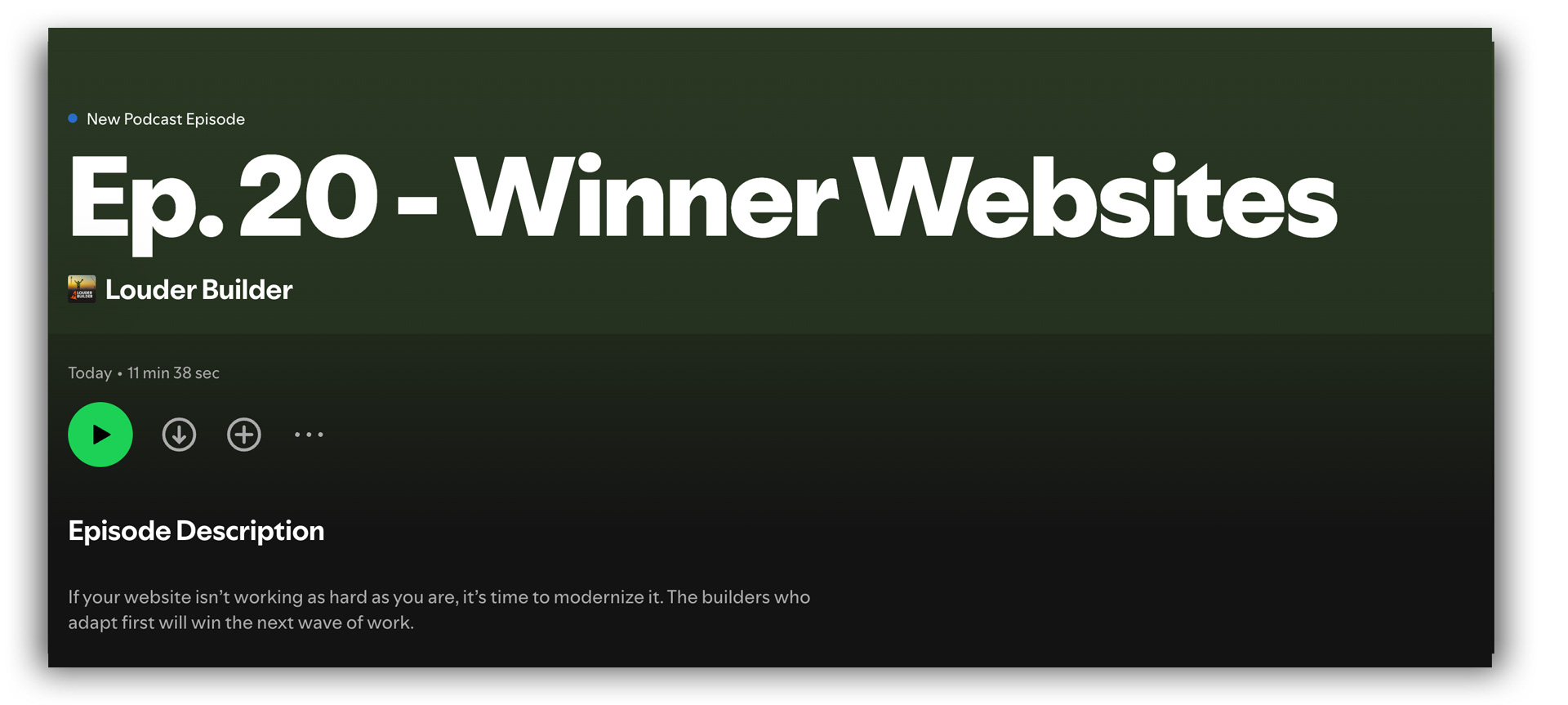Smarten Up Your Website To Win Tomorrow’s Work
In today’s world, your website plays a much bigger role in business development than most builders realize. And if you aren’t keeping it up with the latest trends, it may actually be deflecting incoming business opportunities more than you think.


“Real new business leads will never come through our website.”
That’s what a client told me not long ago.
Now to his credit, he’s a sharp guy. As president of a successful asphalt paving company, he’s convinced his estimators and salespeople, and their efforts alone, are the only reason their project pipeline stays so full.
I’m not arguing with his success. He’s built a strong team and a profitable business. But I couldn’t disagree more about his website instincts.
In today’s world, your website plays a much bigger role in business development than most builders realize. And if you aren’t keeping it up with the latest trends, it may actually be deflecting incoming business opportunities more than you think.
Two Kinds of Builders: Two Different Attitudes
Builders usually fall into two main groups, and your website’s purpose works differently depending on which one you are.
The first is B2C or business to consumer. These are companies like residential home remodelers, roofers, or deck builders serving homeowners in your community. You’ve got crews to keep busy, and an empty spot in your project schedule means lost revenue. You already know online visibility matters, and it’s a pay-to-play game.
You’ve watched your competitors load their websites with keywords and pour money into digital ads, so you’ve done the same - trusting that if you keep spending, the leads will follow. It’s worked before, at least somewhat, so like a ballplayer who won’t change bats during a hitting streak, you stick with it.
On the other hand, B2B (business to business) may include fabricators, material suppliers, paving companies and engineering firms who rely on building and keeping strong relationships with general contractors, architects, or those who are going to be feeding you work in the future.
You tend to see your website as more of a digital brochure - merely a proof of life or verifier of credibility while your team does the real selling. To you, any attention you spend on your website feels like time taken away from estimating, bidding, or following up with your network.
The New Reality
No matter which category you’re in, the way your future clients find, consider, and choose who to work with has changed. You can’t rely on the same thinking or tactics that worked 20, 10, or even 5 years ago. The builders who take time to understand how today’s buyers search and how technology shapes their decisions will have the upper hand in winning tomorrow’s business.
At the same time, here are a few reasons why a website that is still clinging to yesterday’s strategies (or worse: not being updated at all to evolve with the trends) might be costing you opportunities:
Technology is Smarter
Search engines no longer rank websites based on how many keywords or phrases are crammed into them. In fact, they are being penalized and replaced with better quality options.
And they ignore websites with generic information because they appear to be carbon copies of dozens of other similar companies in the industry. If you provide bland details without any unique story to back them up, to them it's just noise.
Instead, they scan and collect information from sites that offer real value. They look for signals like how many pages people visit, how long they stay, how often they come back, and how frequently the content is shared or downloaded. The better the experience and usefulness of your content, the higher your site earns its place.
Prospects Are Wising Up
When doing their research, your prospects have grown skeptical of the first few websites on search results lists. They realize it’s not always the most helpful site that ranks high, but the one stuffed with keywords and tricks to game the system.
To find real, trustworthy information, more people are turning to AI tools like ChatGPT, Claude, or Gemini to do the research for them. Search engines and AI platforms are now stepping in to answer their questions directly, reducing their need to even click on a single website.

The Conversation Starter
No matter how strong you think your reputation is, you have to operate under the assumption your future customers don’t know you yet. And no, even your most trusted colleagues aren’t as faithful as you think.
Your prospects don’t care how long you’ve been in business, what makes you different, or why you’re the right fit for their project. There are plenty of other companies offering the same services, and the truth is, about 85% of their decision-making happens online before you ever get the chance to make your pitch.
The era of treating your website like a static brochure or a keyword trap are over. The job of the modern website is to start a genuine conversation with your prospects, even when you’re not there.
Search engines now favor content that’s helpful, conversational, human centric and answers real questions. Every part of your site, from your Services and Case Studies to your About and Resources pages, should tell a clear, authentic story that reflects your expertise and point of view.
If your site just reports a few generic data points and project photos, it’s not doing enough. You need to explain what you do, how you do it, and why your clients keep coming back. That’s what your ideal future clients, as well as the AI machines in charge of connecting you with them, value today.
Every Page Counts
Keep in mind that if you’re doing content right, most people won’t land on your homepage first. They might land on a service page, a case study, or an article through their custom search terms and criteria. Multiple entry points means every page needs to act as its own landing page, reminding readers who you are and why you’re the perfect fit for their needs.
Use clear writing, strong photos and graphics, and intentional navigation to guide people deeper into your site so they keep learning and gaining confidence in your company. Keep the content short and tight to keep them engaged, and always provide a call to action no matter where they might find themselves in the website.
Reduce Risk
If you put yourself in your prospect’s shoes, it’s easy to see where their concerns come from. Whether it’s a million-dollar infrastructure project or a master bathroom remodel, your prospects see it as a major investment. They’re doing research and looking for someone they can trust so the project won’t blow up in their face.
Your website’s job is to calm those nerves and reduce the feeling of risk.
When showing project examples, don’t just post pretty pictures or generic data - explain how you used your expertise to solve problems along the way. Highlight the challenges you overcame, the process you followed, and the results you delivered. Mention your warranties and guarantees to show you stand behind your work, and link to trusted industry associations that prove your commitment to quality.
These details may seem small, but they make a big difference. The more you show that you’re reliable, skilled, and easy to work with, the faster your prospects will move from cautious to confident - and from curious to committed.
Social Proof is The New Word of Mouth
The best way to win over skeptical prospects is to let them hear from people who’ve already put their trust in you. Nothing builds confidence faster than seeing proof from real clients who faced similar challenges and walked away happy. Use testimonials, case studies, and reviews that tell a story: what the client needed, what obstacles you helped them overcome, and what made working with your team a good experience.
Don’t just quote praise; show results. Before-and-after photos, metrics, or project highlights make your credibility tangible. Video testimonials are even better. Real people talk about their experience with you in short vignettes that make their story genuine and trustworthy.
Trust Is the Ultimate Goal
Search is changing fast. If your site isn’t built for this new era, your competitors’ will be the ones getting the calls. A modern website needs to sound human, offer real answers, and demonstrate credibility through proof, not fluff. Your website is your 24/7 sales rep, the one team member that never takes a day off. Treat it with the respect it deserves, because the builders who evolve with AI-driven search are the ones who will stand apart from the pack, earn trust first, and be the front runner to win tomorrow's best projects.

Written by Rusty George, with almost zero help from Artificial Intelligence. Well, maybe he used one little app to check his grammar, but hey - he's only human.
Rusty George leads a branding, website design and marketing agency serving Seattle and Tacoma area construction companies, developers, subcontractors, manufacturers, material fabricators and suppliers. His goal is to help the building industry become more attractive to the skilled workforce of the future. Reach out to us at any time to get some ideas on how you can modernize your website to land more quality projects.
MORE Insights
Unlock the secrets to transforming your construction company into a marketing powerhouse with Louder Builder.

Small Moves Now. Big Wins Next Year

SEM: You Can’t Win Work If You Can’t Be Found
SIGN UP FOR UPDATES
We will send you our latest insights from Louder Builder as they are released.
CONTACT US
Are you ready to begin your project today? Just have a few questions?
Either way, let’s talk.
